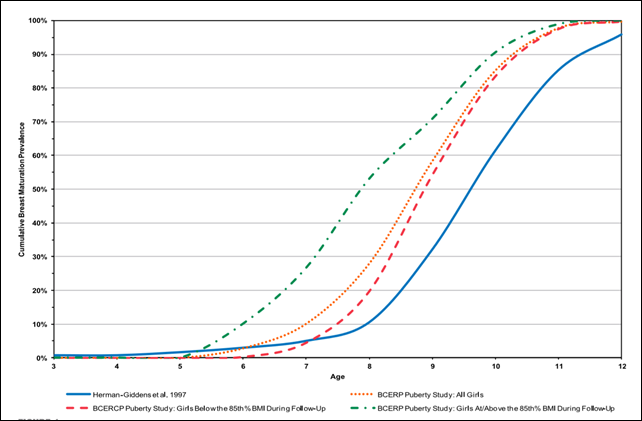More U.S. girls developing breasts before age 9 – ‘It is a warning that something is influencing our child population’
By Genevra Pittman
4 November 2013 (Reuters) – Heavier girls tend to hit puberty at younger ages, according to a new study. Rising obesity rates seem to be a ‘prime driver’ behind breast development starting earlier. Girls are developing breasts at younger and younger ages, a new study confirms. And upward trends in childhood obesity seem to be playing a major role. Researchers found African American girls started getting breasts just before they turned nine, on average. Among white girls the average age was about nine and a half – a few months earlier than in the 1990s. The findings “confirm an ongoing downward trend in pubertal timing among U.S. girls,” said Dr. Anders Juul. “It’s been worrying for the U.S. as well as the rest of the world,” Juul said. He heads the Department of Growth and Reproduction at Rigshospitalet in Copenhagen, Denmark, and wasn’t involved in the new report. The data come from a long-term study of more than 1,200 girls in and around San Francisco, Cincinnati and New York City. Girls were enrolled in the study between ages six and eight and followed with annual or semi-annual visits. At each visit, staff assessed breast development using Tanner stages, which measure how far along a young person is in puberty. African American girls first showed signs of breast development at eight years, 10 months, on average. That compared to nine years, four months among Hispanic girls and nine years, eight months among white and Asian girls. For white girls, puberty hit about four months earlier than in a 1997 study that also measured breast development. That study concluded girls were entering puberty earlier than in the past. Heavier girls tended to start developing at younger ages. Rising obesity rates seem to be a “prime driver” behind breast development starting earlier, Dr. Frank Biro and his colleagues wrote Monday in Pediatrics. Still, Juul’s own work has suggested obesity isn’t behind earlier breast development among Danish girls. Researchers said how much exercise girls get, diabetes precursors and chemicals in the environment that can mimic hormones may all play a role in pushing up the onset of puberty. “One of our challenges is going to be, there are literally hundreds of chemicals that could be candidates,” Biro said. He works in the adolescent medicine division at Cincinnati Children’s Hospital Medical Center in Ohio. Where girls live, meat and dairy in their diets and family stress have also been tied to earlier development, Marcia Herman-Giddens wrote in a commentary on the report. She studies maternal and child health at the University of North Carolina at Chapel Hill. The study didn’t look at when girls started getting their periods, or at other measures of puberty. Related: Boys going through puberty early, just like girls The researchers said maturing at a younger age could come with long-term risks for some girls. For instance, those who hit puberty earlier could be at higher risk of breast and other cancers because their bodies spend more years making and being exposed to estrogen. They also tend to start having sex or using drugs and alcohol at younger ages and are more likely to become depressed or develop low self-esteem. “You’ve got a 10-year-old who looks like a 14-year-old. We interact with kids based on the way that they look,” Biro said. “Kids interact with each other that way also.” “One of the things the parents of these early maturing kids need to do is they need to monitor them more closely,” he told Reuters Health. That includes talking about sex earlier. […] “I think the scary part is not (for) the actual girl, because we don’t know what it means for her,” he told Reuters Health. “It is a warning that something is influencing our child population and it calls for concern and continued studies.” [more]

A blessing in disguise? if humans can get their reproductive cycle times down to the levels of insects and rodents, maybe we can evolve our way out of this mess.